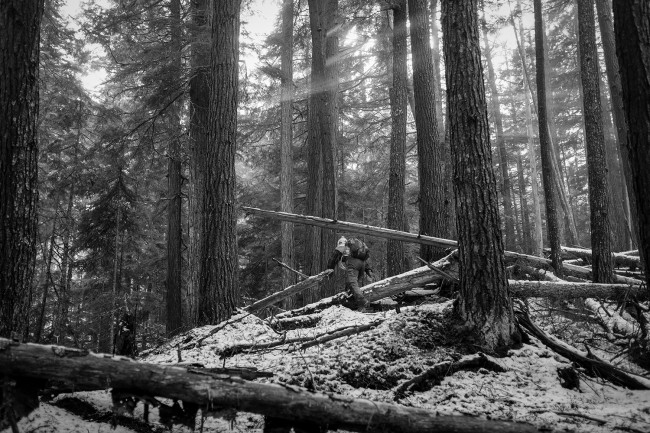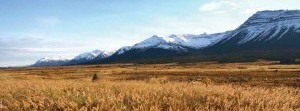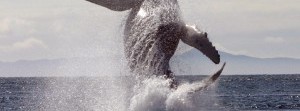
Photo Credit: Mark West
The Rescuers
The email comes the evening before completing this article.
“Here is a live example of what we do,” says Bulkley Valley Search and Rescue (BVSAR) president Fred Oliemans, linking to a CBC story about a search underway for an American family missing in northern BC. The young couple and their children, ages two and three, stare out from my computer screen.
My heart sinks.
British Columbia’s dramatic landscapes offer infinite peaks and gullies to explore and as many places to get lost. You don’t need to be armpit-deep in devil’s club or traversing a lofty glacier. You don’t need to have embarked on an epic, multi-day mission or be bagging a big peak.
You need only to have misplaced a step or the direction of your vehicle.
The province also has some of the world’s best search and rescue operations, with 80 teams and 2,500 volunteers. They receive two-thirds of the nation’s calls, with more than 1,600 incidents reported annually—a number four times what it was in the early 1990s, with notable increases over the last couple years.
“I think it’s a province where everybody wants to play. There’s so much variety in BC,” says Whitney Numan, a search manager with BVSAR. “It’s something BC’s really good at. We are looked at as leaders in search and rescue and it’s all volunteer.”
If you’re out adventuring and lose your way, here’s what happens when you don’t turn up for dinner:
Someone—hopefully—calls RCMP to report your absence. If you’re believed to be in a remote area, RCMP will call Emergency Management BC and its Emergency Coordination Centre contacts search and rescue. Local search managers convene to create a plan and coordinate equipment.
Within an hour or two, they’re out looking for you.
Hopefully, you’ve followed a few simple rules of backcountry travel. Letting someone know where you’re going is a start. Carrying a device that allows you to call in your location will speed up the process. Then, sit tight: If all goes well, you’ll be home for breakfast.
Ninety-five percent of missing persons are found and rescued within 24 hours. The few searches that continue into a second day are elevated to Level 2. Historically, that happens once or twice a year, says Numan, a Level 2 search manager. Last year, the province saw four within three weeks, a trend that continued into 2018 with several Level 2 searches already this year.
One of those was a mushroom picker from Hazelton named Frances Brown, who went missing last October.
By Land Dave Jephson, a search manager and instructor with Terrace Search and Rescue, estimates that up to 25 percent of the calls they receive are for missing mushroom pickers. Not only do these foragers tend to walk with eyes glued to the ground, making it easy to lose your bearings, it’s common not to share your destination for fear of giving up your best picking spot. Between mushroom pickers and hunters, it makes fall a busy season.
The Bulkley Valley, Houston, Vanderhoof, Atlin, Stewart, and Burns Lake each have their own search and rescue operations, but with close to 70 people on its roster, Terrace is one of the largest and most diverse, with skills like long-line helicopter rescues, swift-water rescue, sonar and underwater cameras. It means they are frequently called to assist with searches as far away as Prince George or the Yukon border.
For Terrace and BVSAR, about 30 percent of calls are mutual aid, meaning that various search-and-rescue groups support each other by sharing resources, volunteers, and skills. Last fall’s search for Frances Brown was the biggest ever for BVSAR, with 22 search-and-rescue groups involved from around the province. For seven days, a 36-foot motorhome near the search area became the incident command centre and home base for Numan, who managed the search.
“The conditions were probably the most difficult I’ve ever seen,” he says. Despite more than 100 community and search-and-rescue volunteers each day, weather, terrain, thick brush, and blowdown conspired to bring progress to one-third its normal speed.
It was eight degrees Celsius the day Brown went missing, with overnight lows dropping close to freezing and precipitation falling as everything from rain to sleet to snow. Clad in a raincoat and jeans, she survived the first night by building a fire, which was found smoldering the next morning.
But Brown had moved on.
“She did all the right things,” Numan says. “She was quite smart. The only thing she did wrong was to leave the fire.”
The second day, searchers reported hearing Brown’s calls, likely from a rise in the terrain between where she’d spent the night and where helicopters were landing a few kilometres away.
“My guess is she followed the sound of the helicopters and left the one thing that would have saved her—the fire,” Numan says.
When searchers were unable to reach her that day, he speculates that she had trouble starting another fire and hunkered down, possibly covering herself with brush and moss to stay warm, which would have made it next to impossible for searchers to see her.
By Air Civil Air Search and Rescue Association’s PEP Air was originally mandated to train spotters for the military to search for lost aircraft. Since today’s aircraft usually have emergency locator transmitters on board, it’s less likely for them to go missing.
“Now we are more often called out by RCMP to assist ground search and rescue,” says Lynn Vancadsand, a zone commander with PEP Air responsible for BC’s Northwest.
It was aerial searchers who spotted smoke from Brown’s fire, alerting on-the-ground searchers to her whereabouts.
“Last year, within a two-week period, I had seven callouts,” Vancadsand says, reflecting on last fall’s busy season.
When the call comes from the Emergency Coordination Centre, Vancadsand is put in touch with the search manager and determines what resources are needed. Then she goes in search of a plane, which is also volunteered and needs to hold at least four people and enough fuel for several hours of searching. A team, including pilot, navigator, and two spotters, is compiled from a roster of local volunteers.
“Because this is a volunteer organization, not everyone’s available all the time,” she says. “In saying that, the people that are on my teams will drop just about everything to go out and search.” What they’re looking for is signs of life: bright-coloured clothing, flashing mirrors, fires, direction markers. But the person needs to want to be found, Vancadsand says: Finding someone lying unresponsive is next to impossible.
There’s a strong culture of collaboration between search-and-rescue groups, one that is taking physical shape in Smithers, where an under-construction building at the local airport will bring BVSAR, PEP Air, and the Bulkley Valley Amateur Radio Society together under one roof. The increased efficiency could cut response times in half, or better.
“Eventually, that’s going to save somebody’s life,” says Oliemans, who knows from experience that minutes can be the difference between a happy and a tragic outcome.
A $5 million provincial grant to the BC Search and Rescue Association for distribution among search-and-rescue groups sparked not just the Smithers building, but new bases in Terrace, Vanderhoof, and Houston.
Terrace’s new base, at almost 9,000 square feet, will store equipment, a 2,000-square-foot training room, and meeting rooms. “We’re not building it to store our vehicles. We’re building it to store our future,” Jephson says.
But as search-and-rescue operations expand to meet increased incident rates, the question remains: Are we safer?
The simple explanation for the increase in calls is that more of us carry devices. If you’re within cell range, rescuers are sometimes able to guide you to safety over the phone. Personal locator beacons, like Spot or inReach, allow contact with rescuers from almost any location.
But it’s likely that if people are carrying devices, they also feel emboldened to take greater risks and venture into terrain they may previously have avoided.
The majority of those lost in BC are found safe. Those who don’t survive or remain missing represent only a small fraction of total searches. But that number has increased proportionately to the total number of searches over the past few decades.
So, relying on search and rescue to get you out of a difficult situation may not be in your best interest. It also poses a risk, both mental and physical, for the people looking for you.
The Emotional Toll After seven days in the bush last fall, BVSAR volunteers spent an additional three days searching for Frances Brown this spring.
Then comes the hardest part.
The decision to stop searching is a joint one between search and rescue, police and the family. Once the high-priority areas have been covered, it’s determined that the person is either not there or they are so well hidden that finding them is unlikely.
Although the search officially ends, an RCMP missing person’s file remains open and the area will continue to be used for search-and-rescue training exercises. It’s rare, says Numan. And it’s never easy.
Search-and-rescue volunteers have an eight-percent chance of developing post-traumatic stress disorder, according to the International Critical Incident Stress Foundation. Numan is program coordinator for the province’s Critical Incident Stress Management Program, something he describes as “psychological first aid.”
“Search and rescue volunteers are unique in that they’re passionate, they’re committed and they put in countless hours at no cost,” he says about the importance of providing emotional support. “It’s the right thing to do for people, to give them the help they need, and it also keeps them in search and rescue.”
Hearing the stories of tragedy, it’s easy to wonder why rescuers continue to invest hundreds of volunteer hours each year, sometimes over decades.
In a Smithers café, I’ve just posed this question to Oliemans. Now we’re sitting, in increasingly awkward silence, as I try to clear the lump from my throat.
The incident took place nearly 15 years ago, but it’s still top of his mind: an 11-year-old girl, stuck in a snowy gully on Hudson Bay Mountain. It was almost midnight by the time Oliemans and another volunteer got to her.
“She wouldn’t have made it through the night,” he says. “There’s the odd one like that that keeps you going.”
The day I hit send on this article, I wake up to an email from Vancadsand with more information about the missing American family.
“Today was a really good example of PEP Air, BVSAR and other search-and-rescue groups working together,” she says. “PEP Air flew and searched the area and found the missing people, then guided the ground search-and-rescue teams to them so they could do the rescue.
“It was awesome. Yes, the people are rescued.”
Both Terrace Search and Rescue and BVSAR are fundraising to complete their respective projects. Contributions can be made through BVSAR’s GoFundMe page (search BVSAR) or by emailing NewTerraceSARHall@gmail.com.
STAY SAFE
Emergency Management BC offers the following safety tips for anyone venturing out into the beautiful trails, mountains and backcountry areas of British Columbia:
- Never hike alone. Leave a message with someone on your destination, route and anticipated return time.Be prepared for the elements with proper hiking and contingency gear like extra layers of clothing, a shelter, and something to start a fire with for warmth overnight.
- Bring water—hydration is not only critical during your hike but can sustain you if you get lost.
- Be aware of how far you’ve gone and when you need to turn back to avoid hiking in the dark—always carry a flashlight just in case.
- If you become lost, don’t keep moving. Stay put and wait for help. Don’t presume downhill will get you back on track; downhill can lead you into dangerous terrain.
- Carry a signaling device like a whistle so searchers can find you even if they can’t see you.
- Carry communication and navigation devices, like a cell phone with a full charge, a personal locator beacon, compass or GPS unit.
There are plenty of great resources to be had online, to keep you safe while out adventuring. The non-profit AdventureSmart has some solid info (and they support SAR groups across the country). Check them out at adventuresmart.ca.



